
* The momentum in the exploration of the Red Planet kept up from the 2020 launch window, which saw the flight of the "Perseverance" rover -- an improved derivative of Curiosity -- as well as the first Mars missions of the UAE and China. Further missions are in planning.
* Three missions were sent to Mars in the 2020 launch window. The first was the "Emirates Mars Mission (EMM)", which was launched by a Japanese H2A booster from Tanegashima on 19 July 2020, EMM AKA "Hope" was a Mars orbiter, built by the UAE Space Agency, with assistance from the University of Colorado at Boulder, plus other foreign academic institutions. The EMM had a launch mass of about 1,350 kilograms, with the payload featuring three instruments:
The payload was intended to study temperature patterns; search for ice, water vapor, and dust; and measure the atmosphere's structure and cycles. EMM entered Mars orbit on 9 February 2021. At last notice, it was still operational.
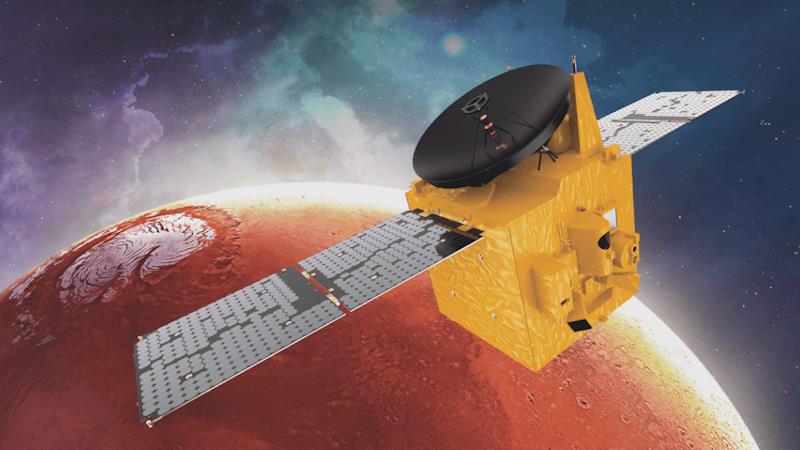
A Chinese Long March 5 booster was launched from the Chinese Wenchang launch center on Hainan Island on 23 July 2020, to send the "Tianwen (Heavenly Questions) 1" probe to Mars for the Chinese National Space Agency (CNSA). The mission included an orbiter, a lander, and a rover carried by the lander. The entire payload weight was 5,000 kilograms. The orbiter itself weighed about 3,715 kilograms and carried seven instrument payloads:
It also carried two deployable "selfie" cameras that could be ejected to provide a view of the probe. In addition, it had a communications relay to allow the rover to communicate with Earth.
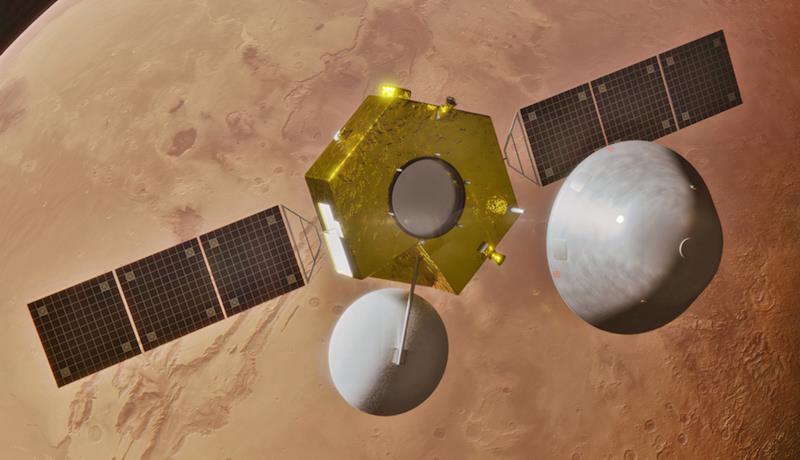
The lander had no instruments, being only intended to land and deploy the six-wheel "Zhurong" rover -- though it did have an emergency locator beacon, built to survive a crash and tell the orbiter where the lander was.
The Zhurong rover had a mass of 240 kilograms. It was solar powered, with flip-out "butterfly" solar panels, and carried six instruments:
It also carried a "remote camera" that could be ejected to observe the lander and rover. Unlike earlier Mars rovers, it did not have a radioactive heating unit to keep it in working condition overnight. Instead, it had two windows to heat up a chemical named "n-undecane" while the Sun was up, melting it, with the chemical then "freezing" again, releasing heat, during the night.
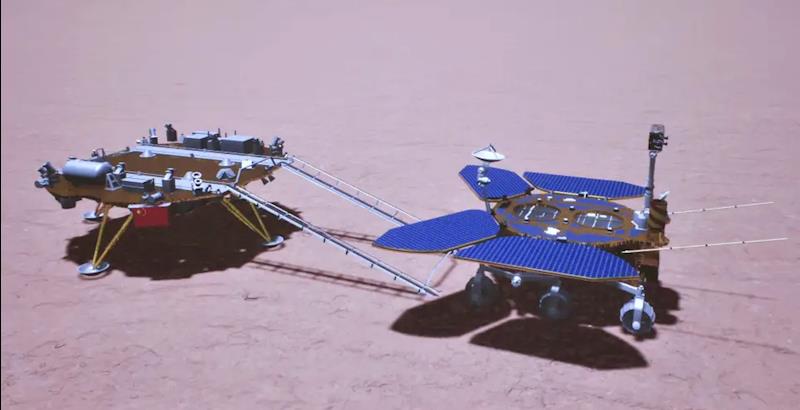
One of the selfie cameras was deployed in September 2020 while the probe was en route to Mars. Tianwen 1 entered Mars orbit on 10 February 2021, with the lander touching down on Utopia Planitia on 14 May, and the Zhurong rover being deployed on 22 May 2021, with the remote camera deployed on 1 June. It was a great success for CNSA. The orbiter's second selfie camera was deployed on 31 December 2021.
Although the rover had been designed for a lifespan of 90 sols (93 Earth days), Zhurong was active for 347 sols (356.5 days), contact being permanently lost on 20 May 2022. The orbiter was still operational at last notice.
* On 30 July, a week after Tianwen 1 was sent to Mars, an Atlas 5 booster was launched to send the "Mars 2020" rover to the Red planet. The rover, named "Perserverance", was an improved Curiosity rover, landed by the same skycrane system.
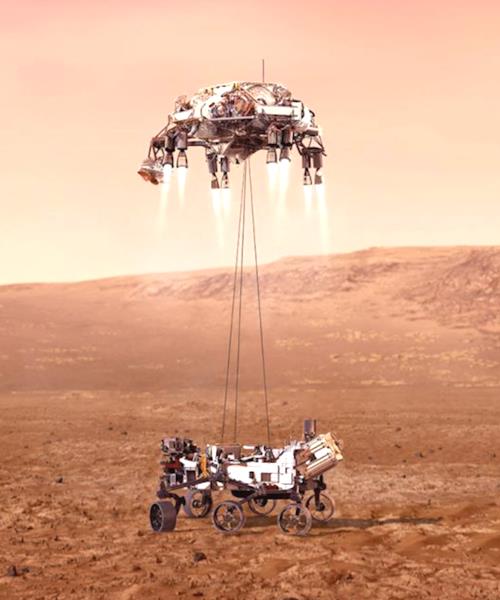
Perseverance, nicknamed "Percy", looked much like Curiosity, but it had stronger wheels, a longer and stronger robot arm, and an updated payload. The all-up system included seven cameras for the landing sequence:
It carried seven primary payload instruments, nineteen cameras, and two microphones. Cameras for navigation were like those of Curiosity, with four Hazcams" on the front of the platform and two on the rear, plus a stereo color "Navcam" system on the mast. There was also a "CacheCam" to monitor stowage of surface samples, more on that later, and a color stereo zoom "MastCam-Z" to observe the rover's surroundings. Science payloads included:
The rover used a RAD750 computer for a brain. In addition, the rover carried a roaming helicopter named "Ingenuity". In was in the form of a cube with twin two-bladed contra-rotating rotors and four fixed landing legs. It was carried in a pack underneath the lander, to be deployed and then carefully unfolded. The rotors had a diameter of 1.2 meters. The helicopter weighed 1.8 kilograms, with the rotors spinning at from 2,400 to 2,900 RPM, about ten times faster than the rotors of a comparable drone helicopter on Earth. The drone was solar-powered, with its payload consisting of miniaturized navigation and high-resolution color cameras. It was to communicate with Earth in the course of its flights through the rover.
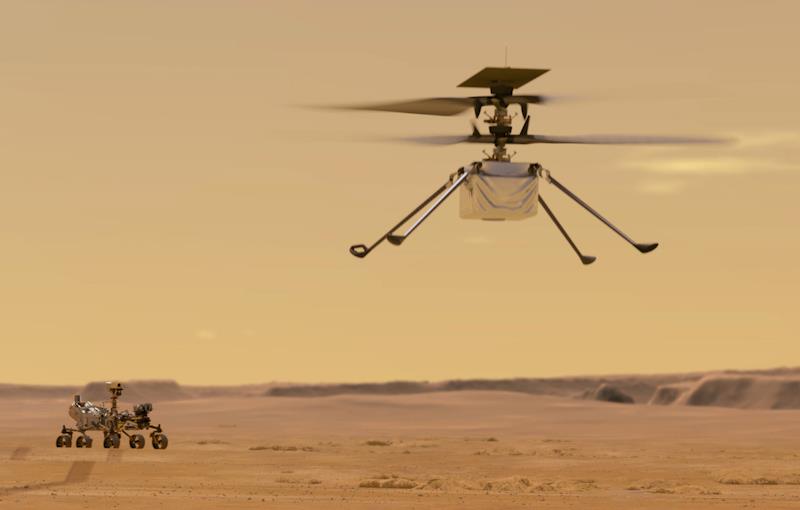
Perseverance touched down in Jezero Crater on 18 February 2021, and has continued to return observations. There was a communications lapse during an Ingenuity flight in January 2024; when communications were re-established, it turned out the helicopter had broken a rotor, and would fly no more. It had flown over 70 times.
* There were no Mars missions in the 2022 launch window, but further Mars flights are planned:
NASA's long-term goal is a "Mars Sample Return (MSR)" effort, developed in conjunction with international partners. The Perseverance rover was, in part, intended to collect samples for MSR. However, MSR is still something of a moving target.
BACK_TO_TOP* The information returned by the series of Mars probes launched since the 1990s is much greater than that returned by all previous missions, and it makes the place seem much more interesting.
Imagery spotted fields of sand dunes and great "dust devils" spinning over the Martian surface. MGS, during its long period of observation, showed small-scale dynamic changes, such as the fresh track of a boulder that fell down a slope sometime in 2004, possibly rolled by a seismic disturbance; and a crater 25 meters in diameter that not only appeared very fresh, but did not appear on Viking 2 orbiter pictures taken in 1976.
Imagery has also revealed what may be evidence of ongoing water seepage. Astronomers suspect that what is happening is that sunlight heats up snow or ice trapped under a blanket of insulating dust, causing it to melt and flow as a liquid. Such actions are implied by images that show gullies associated with banks of water or ice, with gullies appearing over time in sequences of images of the same location. However, there is some controversy over these images, skeptics suggesting they merely reflect dry slides of loose Martian soil.
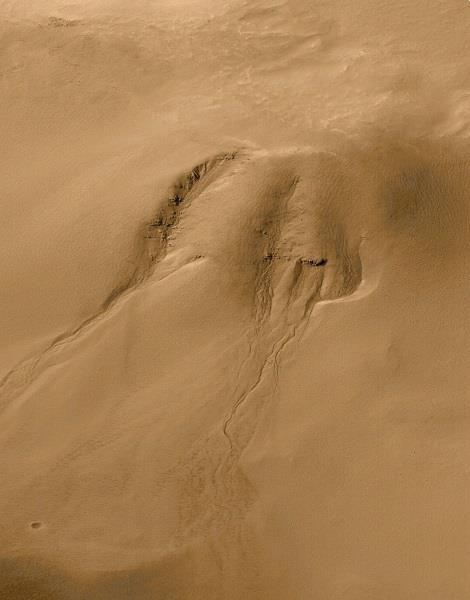
In 2008 MRO's subsurface radar system spotted what appeared to be extensive glaciers buried under surface soil. The presence of the glaciers is not controversial; it is believed there is enough ice in them to cover the entire planet to a depth of a meter, were it evenly distributed. The glaciers are necessarily buried, since otherwise they would have sublimated away long ago in the thin, dry Martian atmosphere.
Mars seems to have undergone significant large-scale changes in the geologically recent past as well. The impression that Mars has been completely dry and dead for over a billion years may be, if not completely wrong, at least overstating the case. Analysis of the density of impact craters on the Martian surface as revealed by the new imagery, which provides an index of how recently the terrain has been resurfaced, indicated that some surfaces seem to have been laid down only 40 million to 100 million years ago. This is a broad range of time estimates, but in any case an order of magnitude more recent than had been previously assumed. Mars may still be volcanically active, at least on an episodic basis.
If there has been volcanic activity on Mars in the not-too-distant past, then it seems more plausible that there has been water activity there as well. One of the Mars meteorites found on Earth, which has been dated to creation 1.3 billion years ago, has rustlike deposits due to water dated to about 650 million years ago, before the rock made its way to Earth. Other Mars meteorites have minerals that were apparently precipitated from a brine. However, so far Mars probes have not identified any major deposits of carbonate minerals, which would have been created by oceans.
The images also show that a Martian surface channel named Marte Vallis was created by water flows within the past few hundred million years. Marte Vallis is near the volcanic Elysium Plains, and it is very plausible that the volcanic activity there melted water in the soil that carved out Marte Vallis. Other images seem to show deep sedimentary layering that would most easily be accounted for by water deposition, as well as what appear to be ancient shorelines.
Some planetary scientists believe the data hints that Mars has undergone episodes of volcanic activity that release water and carbon dioxide to create a warm and wet climate that lasts for about 100,000 years, before returning to the cold and dry normal. Others believe this is implausible and postulate an ancient Mars with icy oceans, whose water eventually became locked up in the ground, only occasionally being released by impacts or volcanic activity.
The probes have returned other significant information. The laser altimeter carried by MGS was used to map out the north polar icecap, demonstrating that it is up to 3,050 meters thick in places, and has a total volume of 1.2 to 1.7 million cubic kilometers. This is about half the size of the Greenland icecap on Earth, and if it all melted, it would cover the Red Planet to a depth of about 9.2 meters. There is also evidence of glacier movements, and of a degree of "global warming", with the south polar icecap retreating an average of about 3 meters a year.
Odyssey expanded on the polar observations, showing that soils around the polar regions consisted of at least half water ice down to a depth of a meter or better. The total area of interest proved about the same size as Canada. Mars researchers had been expecting to find water, but nowhere near this much, and the discovery will clearly influence future Mars exploration efforts. Another interesting discovery by Odyssey was the observation of CO2 "geysers" from the south polar icecap every spring; the geysers left dark patches on the icecap, which had long puzzled planetary researchers.
A particularly intriguing revelation provided by MGS and Odyssey data was announced by researchers in late 2003. Mars was apparently in the middle of an ice age -- that is, it was icier than normal -- anywhere from 400,000 to 2.1 million years ago, and at the height of this ice age, the icecaps may have extended as far south as 30 degrees latitude. Such an ice age would occur, ironically enough, during a period of polar warming, which would lead to the transport of water vapor to lower latitudes. This notion is supported by maps of landscape features provided by the two orbiters that showed a smoothing and rounding of terrain consistent with snowpack, backed up by calculations of variations in the orbit of Mars over the past few million years and computer simulations of Martian climate.
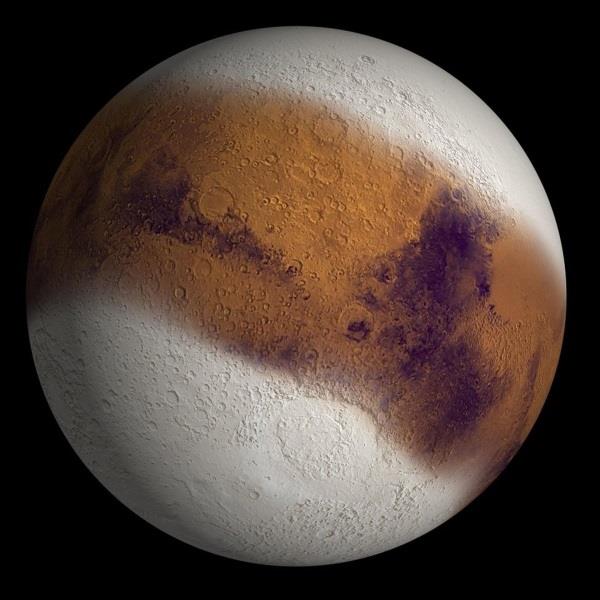
In early 2005, the MEX science team reported what looked like scourings from glaciation in two craters and on Olympus Mons, a finding consistent with a Martian ice age. The glaciation patterns strongly resembled those seen in Antarctica, and remnants of the glaciers still remain buried under dust. One very interesting image returned by Mars Express later in the year showed what looked like a glacial remnant, a neat disk of water ice at the bottom of a crater.
More controversially, MEX researchers reported the discovery of what appeared to be a frozen sea in the Elysium Planum region. Images taken by the orbiter's high-resolution camera showed an area that looked like arctic ice pack on Earth, covered by a layer of dust and volcanic ash. The sea appeared to be about 800 x 900 kilometers in size, with an average depth of about 45 meters. The rate of impact cratering on the sea suggested it had been frozen for about 5 million years. Not too surprisingly, the same area had been noticed by the MGS science team -- but they had concluded the terrain was covered with lava flows, not water ice.
So far, in the absence of any successful dedicated mission to Deimos and Phobos, the two little moons of Mars remain somewhat mysterious. It was, for example, long thought that Deimos and Phobos were captured asteroids; they certainly looked like asteroids from imagery. However, that left the problem of how they had been captured, and also how they had attained such tidy circular orbits, elliptical orbits seeming more plausible. In 2010, results of observations of Phobos by MEX were released that suggested its mineral composition looks much more like that of Mars itself than of an asteroid. The implication is that Deimos and Phobos may have been created by the impact of a body onto the Martian surface in the distant past that threw large chunks of material into orbit.
After NASA canceled work towards a crewed Mars mission in the early 1970s, the idea revived again in the 1980s, if only as a mirage. Ronald Reagan, US president from 1980 to 1988, was fond of grand plans, and during his tenure in office several appropriately big-time space program blueprints were drawn up. One result was the monstrous "Space Exploration Initiative (SEI)", which envisioned a crewed Mars mission and several other major space projects that would take decades and cost hundreds of billions of dollars. The entire idea was absurd in a time of soaring budget deficits, and the only place SEI went was into the archives.
More credibly, the success of the Mariner and Viking probes kept interest in Mars alive among the public, with organizations such as the US-based Planetary Society performing privately funded studies. The private efforts led to the establishment of an informal "Mars Underground", congealing in the mid-1990s in the Mars Society, which continues to promote Mars exploration, with cautious support and encouragement from NASA.
Robert Zubrin, an ex-Martin Marietta engineer and a Mars Society founder, has been the most enthusiastic advocate for a crewed Mars mission. Zubrin and his associates have performed a number of interesting studies on how a crewed Mars expedition might be conducted. The important element in these studies is what is now called, a little stiffly, "in-situ resource utilization (ISRU)", which means obtaining fuel and other mission resources on Mars instead of packing them all the way from Earth. The scheme is known as "Mars Direct", and involves the consecutive launch of several spacecraft in consecutive two-year Mars launch windows.
In the first launch window, a heavy-lift booster (HLB) blasts a 45 tonne Earth Return Vehicle (ERV) to Mars. It carries no crew on the outbound mission, instead being loaded with a store of liquid hydrogen, chemical processing gear, and a set of rovers. One particularly large rover carries a 100-kilowatt nuclear reactor. After an eight-month interplanetary cruise, the ERV skims over the top of Martian atmosphere in an aerobraking maneuver to reduce its interplanetary flight velocity, and then lands using parachutes and retrorockets. The chemical processing gear is put into use, using the liquid hydrogen carried to Mars and the CO2 in the Martian atmosphere to synthesize a store of methane, water, and oxygen to support the exploration team when they arrive at Mars, and also to provide fuel for the return journey to Earth.
In the second Mars launch window, two HLBs are launched. One carries another uncrewed ERV, while the second is a crewed vessel with a crew of four and provisions for three years. The crewed vessel is linked to the upper stage of the HLB that launched it by a tether, with the two spinning together in a lazy circle to provide artificial gravity for the eight-month cruise to Mars.
The two vehicles touch down together in the vicinity of the first ERV. If one ERV fails, the explorers have a backup. If both fail, they have enough provisions to last until another mission can be sent in the next Mars launch window. If both ERVs work OK, the explorers take one home and leave the other for the next pair of launches.
There are variations on this scheme. One envisions conducting the mission with nuclear thermal rocket spacecraft that actually use Martian CO2 for propellant. All these schemes foresee over the long term pairs of HLB shots in each Mars launch window, with each phase building up the Mars base.
Zubrin is the most prominent of the "On To Mars" crowd, but there are others with interesting schemes. Fred Singer, a space researcher with credentials going back to the postwar US experiments with captured German V-2 rockets, has suggested -- following up ideas floated around the Mars community in the early 1980s -- an appealing hybrid of crewed and robotic exploration that would involve using one of the moons of Mars as a forward base.
In this scenario, a crewed interplanetary craft would land on one of the Martian moons and use various kinds of robots, operated with "virtual reality" technology, to conduct exploration of Mars itself. Deimos is preferred for such a mission, since it has a higher and slower orbit than Phobos, allowing the Deimos base to keep in touch with ground rovers. The gravity well for boost back to Earth from Deimos would be much shallower as well.
This mission would be less costly than a crewed Mars landing mission, but would provide much more science value than a series of robotic missions. The astronauts on Deimos would have real-time control over the probes on the surface, and immediate access to samples returned from landers. A network of small communications satellites, which would likely be put into place anyway by precursor robotic missions, would allow the astronauts to monitor probes moving over the planet.
In a more ambitious scenario, astronauts could make short excursions to the surface in small landing craft, while the main base remains on Deimos. Ultimately, a long "skyhook" tether network, with a tether hanging down to Phobos and then a tether hanging from Phobos to the top of the Martian atmosphere, could be used to transfer payloads between Deimos and Mars.
Another interesting idea, though one that inescapably implies a long-term commitment to Mars exploration, is the "cycler". The idea was originally proposed in the early 1980s by two researchers at Science Applications International Corporation named Alan C. Friedlander and John C. Neihoff.
Their idea was to build one or more space stations, which they called "castles", and put them into an orbit around the Sun that periodically passed by Mars and Earth. Astronauts could take a "taxi" to a castle as it passed by Earth, endure a fairly long trip to Mars, and then take a taxi at the Mars end down to the planet. Once the castle was in its proper orbit around the Sun, it would stay there indefinitely without requiring large quantities of propellant.
Early concepts envisioned a castle as passing Earth every 5 years and passing Mars every 3.75 years, or passing Earth every 3 years and passing Mars every 7.5 years. In 1985, ex-Apollo astronaut Buzz Aldrin -- who has a degree in orbital mechanics from the Massachusetts Institute of Technology -- suggested modified orbits that extended well beyond Mars, and use gravity assist maneuvers to allow encounters with each planet on an interval of about 2.7 years, with transit times as low as six months. The propulsion requirements were greater for such a scheme, but not a great difficulty, since high-efficiency electric ion rocket engines could be used.
The Cycler did have the problem that it zipped by Mars at a very high speed, up to 43,500 KPH. This wouldn't be too much of a problem for arrival, since a spacecraft could use aerobraking to burn up its velocity, but it would be very difficult for a crew trying to return to Earth to catch a ride on the Cycler. Aldrin came up with a separate "Semi-Cycler" for the return trip, which would take about 14 months to come from Earth; aerobrake into a loose, wide Mars orbit for four months; and then boost out of Mars orbit to return to Earth in eight months. It would require fuel for the boost, but that could be provided by indigenous propellants boosted up from Mars.
In early 2004, US President George W. Bush issued a new "Constellation" plan for NASA that ultimately projected a crewed Mars mission. There was skepticism over the announcement, with some dismissing the proposal as mere election-year hype.
The road map for Constellation was fleshed out by NASA before the end of 2005. The plan at the time envisioned development of a new "Orion" crew exploration vehicle that would be something like a scaled-up Apollo capsule, along with a new and bigger lunar module. The Orion was to be launched by the "Ares 1" booster, derived from the space shuttle solid-rocket booster, with a heavy-lift shuttle-derived "Ares 5" lifting the lunar module and other large assemblies. Initially, the Orion was simply to be used for trips to the International Space Station, but the second-stage plan envisioned new trips to the Moon and setting up a Moon base as a stepping stone towards a crewed Mars expedition.
However, nobody could ever identify where the money was going to come from to fully implement Constellation. Work on the Orion and Ares 1 components of the plan began to suffer badly from cost escalation and schedule slips, with no prospect of funding the rest of the Constellation scheme. In early 2010, with budget deficits once again soaring, the Obama Administration gave the program the axe. After considerable discussion, the current crewed spaceflight plan is focusing on crewed flights to the International Space Station being provided by commercial entities -- Elon Musk's SpaceX firm with its "Dragon" capsule, and Boeing with its "CST-100" capsule -- while deep-space missions will be conducted with the Orion capsule, with an HLB evolved from the Ares 5 being used for launches.
No space agency is currently working on a plan for a crewed Mars flight. This has not prevented Elon Musk, always inclined to think big, from saying SpaceX will conduct such a mission in the 2020s. One wishes him well, while taking a wait-&-see attitude. One major problem with current scenarios is that they envision long Earth-Mars transit times, which imply extended exposure of the Mars astronauts to cosmic radiation and extended wasting of their bodies in zero-gee: while a crewed mission to Mars lasting 180 days would be practical, there is uncertainty over the practicality of anything longer than that.
Over the long run, human voyages to Mars and even the colonization of the Red Planet seems very plausible. Some researchers have considered a scheme for converting Mars into a reasonable imitation of Earth, "terraforming" it into a planet with a breathable atmosphere.
The idea of terraforming Mars has been around for decades. Mars appears to possess many of the materials needed to generate an Earthlike atmosphere: carbon dioxide in its atmosphere and in extended ice caps that appear in the winter; water, and so hydrogen and oxygen, buried in the permafrost, in the ice caps that exist year-round, and underground; and nitrogen locked into the soil compounds. In the early 1990s, two NASA researchers, Chris McKay and Owen Toon, in collaboration with James Kasting of Penn State, provided a detailed plan of how Mars could be made more like Earth.
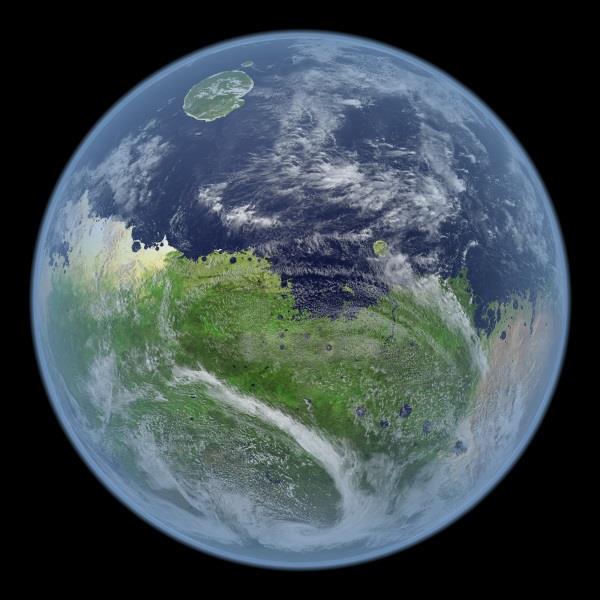
Mars is at present an inhospitable environment. River channels and other topographical features suggest that 3.5 billion years ago the planet was warm, had water flowing across its surface, and had a relatively thick atmosphere. Over time, the atmosphere was absorbed into the soil and lost to space in the planet's low gravity. Most of the water would have frozen into the soil and contracted into the polar caps; the rest would have evaporated into space.
The first step in terraforming Mars would be to raise the temperature. Mars is very cold because it is 1.52 times as far from the Sun as the Earth, and only receives 43% as much sunlight. Early terraforming plans envisioned placing giant mirrors in orbit around the planet, but a more elegant scheme was discovered by accident here on Earth.
Industrial activity has inadvertently raised the amount of carbon dioxide and chlorofluorocarbons (CFCs) in the Earth's atmosphere. These "greenhouse gases" trap more of the Sun's heat, threatening the Earth with rising temperatures. On Earth, greenhouse gas buildup is a threat, but on Mars, it could be a blessing. Although the Martian atmosphere is mostly carbon dioxide, it is so thin that it cannot retain much heat. Adding CFCs would allow it to retain more. The Martian soil is believed to be rich in chlorine, fluorine, carbon, hydrogen and other CFC building blocks. If factories could be built to synthesize and release several million tonnes of CFCs, they could raise the temperature 30 degrees Celsius in a year.
The problem is that solar ultraviolet radiation tends to break down CFCs and so limit their concentration. Even if a CFC were synthesized to resist ultraviolet breakdown and retain its heat-trapping infrared absorption, it would still have to be replenished continuously. However, once temperatures reached about -30 degrees Celsius, Martian soil would begin to release carbon dioxide, increasing the temperature further. As the temperature climbed still more, the rate of release would increase. Once average temperatures went above freezing, water vapor would begin to be released from permafrost, the polar icecaps, and underground ice deposits.
This process could take anywhere from 100 to 100,000 years, depending on how carbon dioxide is distributed in the planet's surface. In any case, once water vapor began to be released in quantity, a few tough plant species could be planted on the surface. Unfortunately, the soil may not contain enough nitrogen, in the form of nitrites and nitrates, to support plant metabolism. Microorganisms could be seeded into the soil to help the plants access the nitrogen.
As water was released, it could pose another problem, not because there wouldn't be enough of it, but because there would be too much. Mars appears to have been a surprisingly wet place in its early history, and as the planet warmed and the atmosphere grew denser, lakes and oceans could form once again. The problem arises because carbon dioxide has an affinity for water. Atmospheric CO2 tends to dissolve into water and form limestone, reducing the concentration of carbon dioxide in the atmosphere. On Earth, continental drift moves the limestone into the interior of the planet, where it is heated and vented back to the atmosphere by volcanic processes. Martian terraformers would need to recover the limestone and recycle it back into carbon dioxide and water.
As plants spread, they would also break down atmospheric CO2 by converting it into oxygen, which is necessary to support animal life. However, plants are inefficient at this job, and bringing the atmospheric concentration of oxygen up to 20%, the same as the Earth, could take 100,000 years. The process could be sped up by genetic engineering, presuming that evolution hasn't optimized it to its maximum capability already. In any case, it would take at least 1,000 years.
If the job were completed, though, Mars would indeed appear much like Earth. The sky would be blue, the clouds white, rain would fall, nitrogen would serve as a buffer gas to dilute the oxygen, and there would be a protective ozone layer. To preserve that new ozone layer and prevent a runaway greenhouse effect, the CFCs manufactured from this time on would have to be ozone-friendly, that is, without chlorine. The rest of the atmosphere would be mostly CO2. There would be enough of it to sustain the planet's plants, and the CO2 could be regularly replenished by soil outgassing and limestone recycling. Full colonization of the planet would then begin.
Other researchers have replied that such a scheme is too simplistic, and there is another question that has to be seriously addressed: do we have the right to completely remake another planet? We have come to appreciate the need for preservation of nature on Earth, and so we have to also consider the idea that the Martian environment should not be destroyed to accommodate humans. The fact that Mars is by all evidence lifeless makes this argument a hard sell. It still remains a question worth asking, and since such a terraforming project is not likely to be seriously planned for decades or even centuries, it's not like we don't have time to think it over.
BACK_TO_TOP* One of the interesting footnotes to Mars exploration was the discovery of pieces of Martian rock that had made their way to Earth. The story began with the analysis of strange meteorites known as "SNCs", the acronym standing for the three locations where they were found -- Chassigny in France (1815), Nakhla in Egypt (1911), and Shergotty in India (1865). The "snicks" had strange compositions, with a high proportion of volatiles and (as was found once chemical isotopes were understood) odd oxygen isotope ratios. In particular, they were made up of igneous -- volcanic -- rock. Most meteorites come from asteroids and comets, which don't have volcanoes. Volcanoes are associated with planets.
In the early 1980s, radioactive dating showed the SNCs ranged from 180 million to 1.3 billion years old. Asteroids and comets, in contrast, date from the origin of the solar system and are about 4.6 billion years old. This led to the idea that the SNCs were fragments of some other planet, Mars being the prime suspect, ejected into space by meteorite impacts and then swept up by the Earth. An analysis of gases in a bubble inside a SNC showed that the gas composition matched that of the atmosphere of Mars, and the idea that the SNCs were from Mars became generally accepted.
A few years later meteorites were recovered from the ice sheets around the Allan Hills in Antarctica. One, designated ALH84001 -- the "ALH" standing for "Allan Hills" -- proved to be a Mars meteorite under inspection by NASA researchers. Further careful analysis of isotopes embedded in its surface layer showed that it had been in space for about 16 million years, not all that long in geological terms; and the decay of these isotopes from the time ALH84001 fell to Earth and stopped being bathed in cosmic radiation meant it had been lying on the Antarctic ice for about 16,000 years.
Close inspection showed that ALH84001 contained tiny blobs of carbonate materials that contained hydrocarbons and what looked like sausage-shaped fossils. The evidence suggested that ALH84001 contained evidence of Martian bacteria. A public announcement was made by NASA in 1996, though the researchers were careful to say that the evidence was merely suggestive and did not remotely amount to proof. There was considerable excitement over the announcement -- but many rebuttals followed, and interest in the matter faded out.
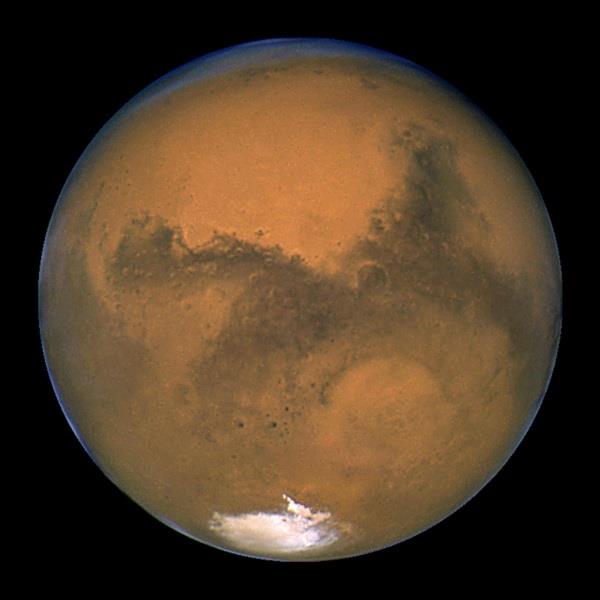
* From 2000 to 2002, I wrote a series of documents on planetary exploration, and then consolidated them in 2002 into a unified document, THE EXPLORATION OF THE PLANETS. It turned out to be too big and hard to maintain, so from 2021 I broke in down into components again. The initial release of this stand-alone Mars document was in 2023.
Sources include:
Of course, a number of websites were consulted as well as print sources. One of the most important was Bill Arnett's excellent "A Multimedia Tour Of The Solar System", which is not only readable and thorough in itself, but provides an extensive set of links for investigation down to excruciating detail. The NASA, ESA, and JAXA websites were also consulted for news releases to stay up to date.
Illustrations details:
* Revision history:
v3.0.0 / 01 feb 24 / Extract of stand-alone document.BACK_TO_TOP
